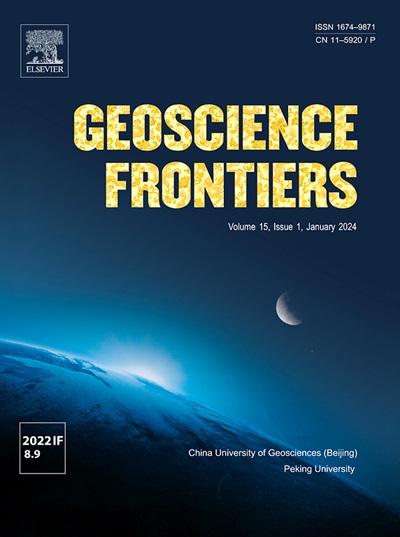Laboratory experiments of carbon mineralization potential of the main terrestrial basalt reservoirs in China
IF 8.5
1区 地球科学
Q1 GEOSCIENCES, MULTIDISCIPLINARY
引用次数: 0
Abstract
Against the background of realizing the goal of “carbon peaking and carbon neutrality”, using basaltic rocks for carbon mineralization is one of the most promising approaches to reduce the rise in atmospheric CO2 concentrations. This study conducted a series of experiments to assess carbon mineralization in nine basalt samples from the main terrestrial basalt reservoirs in China within CO2-H2O/brine-rock systems at low temperatures (≤35 °C). The results indicate that the secondary carbonates formed in the CO2-H2O/brine-basalt system are predominantly calcite rather than Mg-carbonate minerals at low temperatures (≤35 °C). Hence, at low temperatures (≤35 °C), basalt rich in Ca-bearing minerals promotes the formation of stable carbonate minerals more effectively than basalt containing Mg-bearing minerals. Furthermore, under conditions of low temperatures (≤35 °C) and pressures of approximately 3 MPa, the results suggest that alkaline olivine basalt, with a higher content of Ca-minerals and typical alkaline minerals (nepheline and Na-sanidine), exhibits the highest pH value and the highest amount of calcite. Hence, the alkaline minerals, nepheline and Na-sanidine, serve as pH buffers to increase the pH and promote the precipitation of calcite within CO2-H2O– basalt systems at low temperatures (≤35 °C). Among the nine evaluated basalts, basalt from the Shandong Linqu-Changle volcanic basin exhibits the highest rate of carbon mineralization at low temperatures (≤35 °C). Hence, Cenozoic alkaline olivine basalt from Shandong Linqu-Changle volcanic basin is one of the most promising basalt reservoirs in China for future in- situ carbonation. As for ex- situ carbonation, compared with olivine, diopside or Ca-plagioclase may be more appropriate for increasing ocean negative emissions.

中国主要陆相玄武岩储层碳矿化潜力的实验室实验
在实现 "碳封顶、碳中和 "目标的背景下,利用玄武岩进行碳矿化是降低大气二氧化碳浓度上升的最有前景的方法之一。本研究在低温(≤35 °C)CO2-H2O/卤素岩体系中,对来自中国主要陆相玄武岩储层的九个玄武岩样品进行了一系列碳矿化评估实验。结果表明,在低温(≤35 ℃)条件下,CO2-H2O/卤水-玄武岩体系中形成的次生碳酸盐主要是方解石,而不是碳酸镁矿物。因此,在低温(≤35 °C)条件下,富含含钙矿物的玄武岩比含有含镁矿物的玄武岩更有效地促进稳定碳酸盐矿物的形成。此外,在低温(≤35 °C)和约 3 兆帕的压力条件下,结果表明,碱性橄榄石玄武岩含有较多的钙矿物和典型的碱性矿物(霞石和钠矽烷),显示出最高的 pH 值和最高的方解石含量。因此,碱性矿物(霞石和 Na-sanidine )可作为 pH 缓冲剂,在低温(≤35 °C)条件下提高 CO2-H2O 玄武岩体系的 pH 值,促进方解石的沉淀。在评估的九种玄武岩中,山东临朐昌乐火山盆地的玄武岩在低温(≤35 °C)下的碳矿化率最高。因此,山东临朐-昌乐火山盆地的新生代碱性橄榄岩玄武岩是中国最有希望进行原位碳化的玄武岩储层之一。至于原地碳化,与橄榄石相比,透辉石或钙斜长石可能更适合增加海洋负排放。
本文章由计算机程序翻译,如有差异,请以英文原文为准。
求助全文
约1分钟内获得全文
求助全文
来源期刊

Geoscience frontiers
Earth and Planetary Sciences-General Earth and Planetary Sciences
CiteScore
17.80
自引率
3.40%
发文量
147
审稿时长
35 days
期刊介绍:
Geoscience Frontiers (GSF) is the Journal of China University of Geosciences (Beijing) and Peking University. It publishes peer-reviewed research articles and reviews in interdisciplinary fields of Earth and Planetary Sciences. GSF covers various research areas including petrology and geochemistry, lithospheric architecture and mantle dynamics, global tectonics, economic geology and fuel exploration, geophysics, stratigraphy and paleontology, environmental and engineering geology, astrogeology, and the nexus of resources-energy-emissions-climate under Sustainable Development Goals. The journal aims to bridge innovative, provocative, and challenging concepts and models in these fields, providing insights on correlations and evolution.
 求助内容:
求助内容: 应助结果提醒方式:
应助结果提醒方式:


